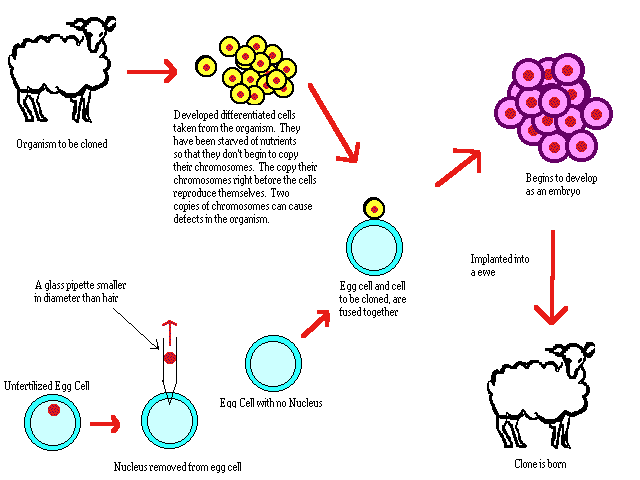Hello Mam ,
I have joined you . Nice to see your blog.
cloning
CLONING

Dolly
Saturday, August 21, 2010
Friday, August 20, 2010
Cloning
research about the cloning of different organisms done uptil now and share
Dolly the Sheep
Main article: Dolly the Sheep
Dolly, a Finn-Dorset ewe, was the first mammal to have been successfully cloned from an adult cell. She was cloned at the Roslin Institute in Scotland and lived there from her birth in 1996 until her death in 2003 when she was six. Her stuffed remains were placed at Edinburgh's Royal Museum, part of the National Museums of Scotland.
Dolly was publicly significant because the effort showed that the genetic material from a specific adult cell, programmed to express only a distinct subset of its genes, can be reprogrammed to grow an entire new organism. Before this demonstration, it had been shown by John Gurdon that nuclei from differentiated cells could give rise to an entire organism after transplantation into an enucleated egg.[6] However, this concept was not yet demonstrated in a mamallian system.
Cloning Dolly the sheep had a low success rate per fertilized egg; she was born after 237 eggs were used to create 29 embryos, which only produced three lambs at birth, only one of which lived. Seventy calves have been created and one third of them died young; Prometea took 277 attempts. Notably, although the first clones were frogs, no adult cloned frog has yet been produced from a somatic adult nucleus donor cell.
There were early claims that Dolly the Sheep had pathologies resembling accelerated aging. Scientists speculated that Dolly's death in 2003 was related to the shortening of telomeres, DNA-protein complexes that protect the end of linear chromosomes. However, other researchers, including Ian Wilmut who led the team that successfully cloned Dolly, argue that Dolly's early death due to respiratory infection was unrelated to deficiencies with the cloning process.
Though Dolly was the first cloned mammal, the first vertebrate to be cloned was a tadpole in 1952
Dolly the Sheep
Main article: Dolly the Sheep
Dolly, a Finn-Dorset ewe, was the first mammal to have been successfully cloned from an adult cell. She was cloned at the Roslin Institute in Scotland and lived there from her birth in 1996 until her death in 2003 when she was six. Her stuffed remains were placed at Edinburgh's Royal Museum, part of the National Museums of Scotland.
Dolly was publicly significant because the effort showed that the genetic material from a specific adult cell, programmed to express only a distinct subset of its genes, can be reprogrammed to grow an entire new organism. Before this demonstration, it had been shown by John Gurdon that nuclei from differentiated cells could give rise to an entire organism after transplantation into an enucleated egg.[6] However, this concept was not yet demonstrated in a mamallian system.
Cloning Dolly the sheep had a low success rate per fertilized egg; she was born after 237 eggs were used to create 29 embryos, which only produced three lambs at birth, only one of which lived. Seventy calves have been created and one third of them died young; Prometea took 277 attempts. Notably, although the first clones were frogs, no adult cloned frog has yet been produced from a somatic adult nucleus donor cell.
There were early claims that Dolly the Sheep had pathologies resembling accelerated aging. Scientists speculated that Dolly's death in 2003 was related to the shortening of telomeres, DNA-protein complexes that protect the end of linear chromosomes. However, other researchers, including Ian Wilmut who led the team that successfully cloned Dolly, argue that Dolly's early death due to respiratory infection was unrelated to deficiencies with the cloning process.
Though Dolly was the first cloned mammal, the first vertebrate to be cloned was a tadpole in 1952
Subscribe to:
Posts (Atom)